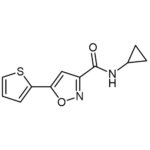| Product Name | ISX9 |
| Description |
Induces neuronal differentiation |
| Purity | >99% (TLC); NMR (Conforms) |
| CAS No. | 832115-62-5 |
| Molecular Formula | C11H10N2O2S |
| Molecular Weight | 234.3 |
| Field of Use | Not for use in humans. Not for use in diagnostics or therapeutics. For in vitro research use only. |
Properties
| Storage Temperature | -20ºC |
| Shipping Temperature | Shipped Ambient |
| Product Type | Inducer |
| Solubility | May be dissolved in DMSO (60 mg/ml): or ethanol (16 mg/ml, warm) |
| Source | Synthetic |
| Appearance | Tan powder |
| SMILES | C1CC1NC(=O)C2=NOC(=C2)C3=CC=CS3 |
| InChI | 1S/C11H10N2O2S/c14-11(12-7-3-4-7)8-6-9(15-13-8)10-2-1-5-16-10/h1-2,5-7H,3-4H2,(H,12,14) |
| InChIKey | SYENTKHGMVKGAQ-UHFFFAOYSA-N |
| Safety Phrases | Classification: Warning |
| Cite This Product | ISX9 (StressMarq Biosciences Inc., Victoria BC CANADA, Catalog # SIH-628) |
Biological Description
| Alternative Names | N-Cyclopropyl-5-(2-thienyl)-3-isoxazolecarboxamide; ISX; Isoxazole-9 |
| Research Areas | Calcium Signaling, Neuroscience, Neurotransmission, Stem Cells, Calmodulin, CamK |
| PubChem ID | 19582717 |
| Scientific Background | ISX9 is a small molecule known for its neurogenic properties. It promotes neurogenesis by enhancing the proliferation and differentiation of neural progenitor cells, particularly in the hippocampal subgranular zone. ISX9 induces neuronal gene expression and suppresses astrocytic phenotypes, facilitating reprogramming of glial cells toward neuronal lineages. It has been shown to improve memory and cognitive function in animal models and is being explored for its potential in regenerative therapies for neurodegenerative diseases and brain injury. |
| References |
1. D Petrick et al. FASEB J. 2012 26:3148 2. JW Schneider et al. Nat. Chem. Biol. 2008 4:408 3. EM Dioum et al. Proc. Natl. Acad. Sci. U.S.A. 2011 108:20713 4. L Zhang et al. Differentiation 2011 81:233 5. RQ Ali et al. Am. J. Stem Cells 2016 5:19 6. LE Bettio et al. Neuroscience 2016 332:212 |



Reviews
There are no reviews yet.